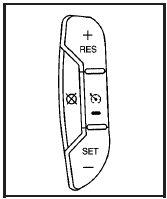Cruise Control
With cruise control, you can maintain a speed of about 40 km/h (25 mph) or more without keeping your foot on the accelerator. Cruise control does not work at speeds below about 40 km/h (25 mph).
WARNING:
Cruise control can be dangerous where you
cannot drive safely at a steady speed. So, do not
use the cruise control on winding roads or in
heavy traffic.
Cruise control can be dangerous on slippery
roads. On such roads, fast changes in tire traction
can cause excessive wheel slip, and you could
lose control. Do not use cruise control on slippery
roads.
If your vehicle has the Traction Control System (TCS) and the cruise control is on, TCS will begin to limit wheel spin and the cruise control automatically turns off.
See Traction Control System (TCS). When road conditions allow you to safely use it again, the cruise control can be turned back on.

The cruise control buttons are located on left side of the steering wheel.
 (On/Off): Press to turn cruise
control on and off.
(On/Off): Press to turn cruise
control on and off.
The indicator is lit when cruise control is on.
+ RES (Resume/Accelerate): Press to make the vehicle accelerate or resume to a previously set speed.
SET–: Press to set the speed or make the vehicle decelerate.
 (Cancel): Press to cancel cruise
control.
(Cancel): Press to cancel cruise
control.
See also:
Oil Pressure Gage
The oil pressure gage shows the engine oil
pressure in psi (pounds per square inch) when the
engine is running. Canadian vehicles indicate
pressure in kPa (kilopascals).
Oil pressure may vary ...
On the Road
The LaCrosse moves out when pushed, but its capabilities stop short of an
all-out sport sedan's — fine by me, seeing as no one ever wanted Buick to build
the next BMW. The LaCrosse CXS, which pa ...
Replacement Bulbs
For replacement bulbs not listed here, contact your dealer. ...


